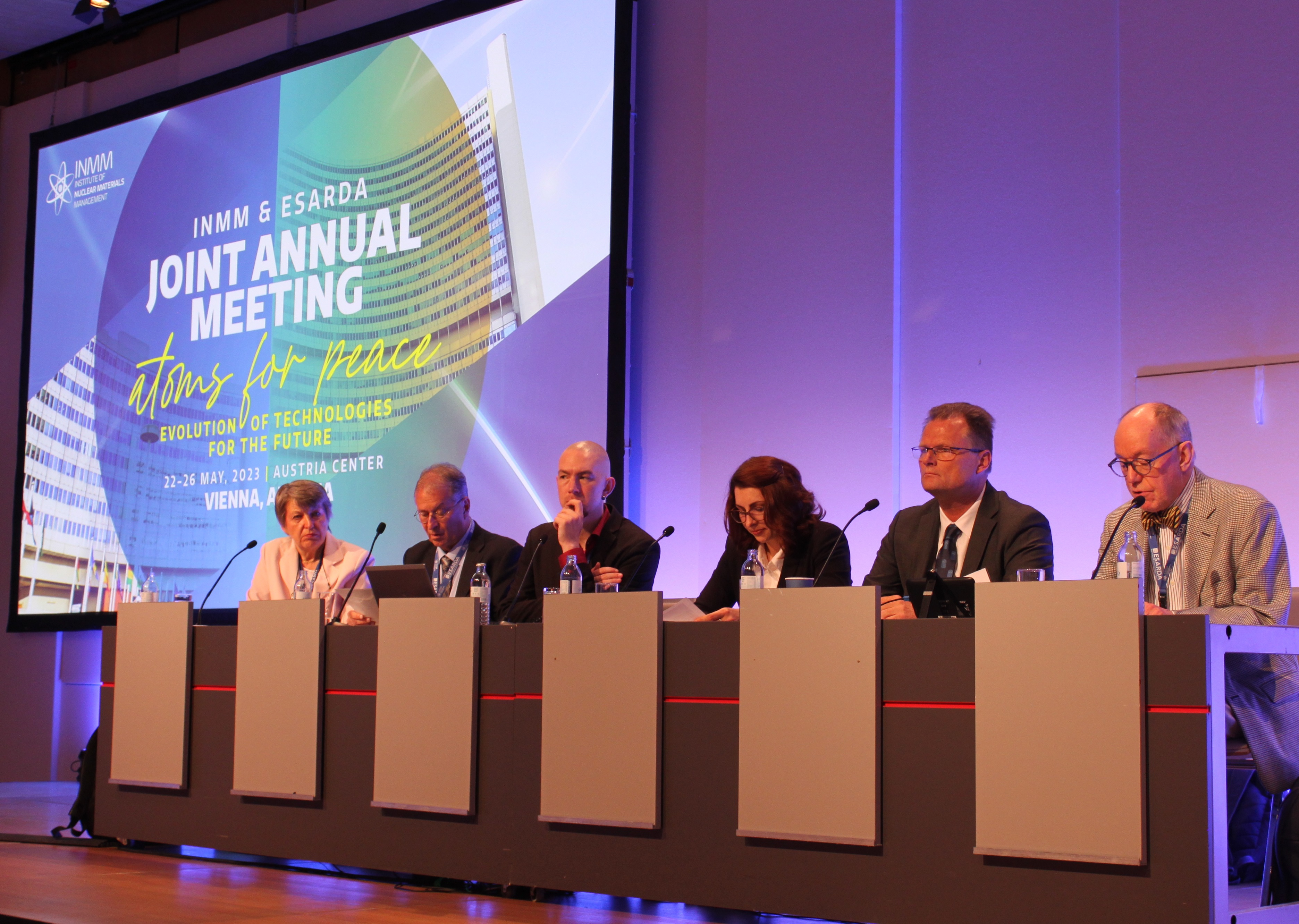
A joint annual meeting of the Institute for Nuclear Materials Management (INMM) and the European Safeguards Research and Development Association (ESARDA) took place in Vienna from 22 to 26 May 2023. VCDNP Senior Fellow Laura Rockwood and Research Associate Noah Mayhew presented in seven sessions during the meeting, as detailed below. In addition, Ms. Rockwood co-chaired an eighth session that focused on material out of regulatory control.
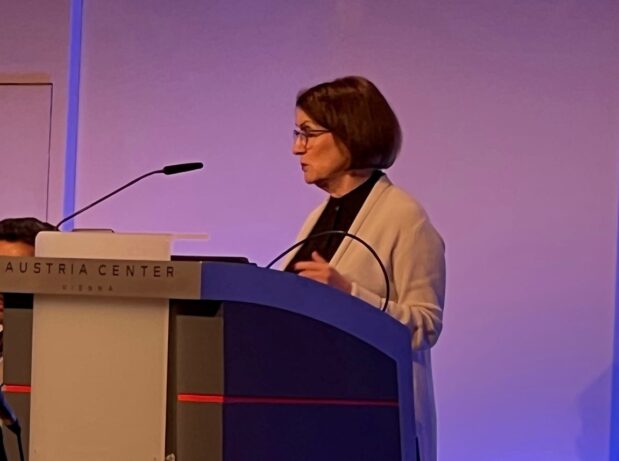
At each of its annual meetings, the INMM holds a workshop on “Policy and Technical Fundamentals of International Safeguards”. Ms. Rockwood joined the workshop as one of the lead instructors, discussing the impact of the Model Additional Protocol (Model AP) on non-nuclear-weapon States from a State perspective, as well as associated challenges and opportunities. Ms. Rockwood’s remarks drew from two studies conducted by the VCDNP. The first, authored by Ms. Rockwood, was published in 2018. Mr. Mayhew was the principal author of the second study, which was published in 2023 and is described in more detail in the next section.
In terms of challenges, Ms. Rockwood noted three categories of challenges described by the 20 States (plus Euratom) that had provided answers to the questionnaire that formed the basis for the 2018 study. The first was identification of relevant stakeholders and locations not subject to safeguards without an additional protocol (AP) in force. The second was raising awareness among such stakeholders of the new requirements associated with APs, particularly regarding declarations of nuclear fuel cycle-related research and development activities not involving nuclear material. The third category of challenges related to the collection and submission of necessary information to the International Atomic Energy Agency (IAEA).
Despite challenges, the 2018 study also demonstrated that there are benefits to non-nuclear-weapon States in concluding APs. Of 15 surveyed States that were under integrated safeguards, 14 responded that they had observed a decrease in inspection frequency since AP implementation. Surveyed States also noted that implementation of their APs had improved control within the State of nuclear material, equipment and related activities. They had also gained a better understanding by the regulatory body of nuclear-related research and development activities, as well as export control requirements. Finally, surveyed States reported that cooperation between State authorities and the IAEA and Euratom had improved since AP implementation.
The 2023 study—detailed below—yielded similar insights in terms of State experience, and sought to provide Member State-driven recommendations for improving the impact of outreach and capacity building activities in safeguards with a view to strengthening State capacity to bring into force and implement APs.
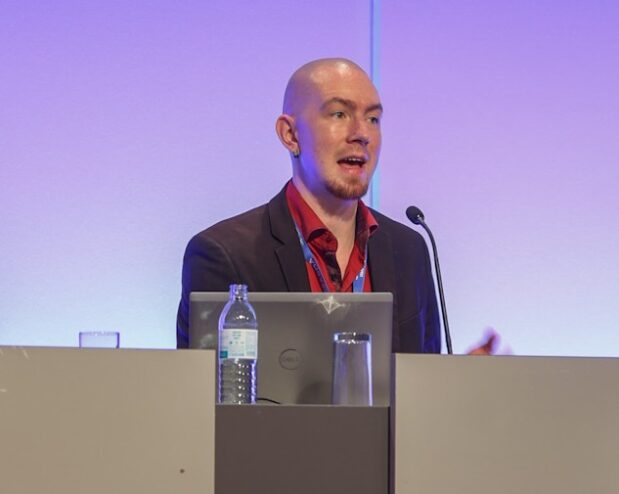
Mr. Mayhew presented the findings of a new VCDNP study entitled “Understanding States’ Experiences in Safeguards: Challenges to and Opportunities for Entry into Force and Implementation” at a session on “Strengthening Safeguards at the State level”. This research project was led by the VCDNP in cooperation with the Verification Research, Training and Information Centre (VERTIC) and aimed to provide actionable, Member State‑driven recommendations for the IAEA, States and Groups of States to enhance the impact of their safeguards outreach and capacity-building activities. Having spoken with representatives from 17 States that had recently taken steps to adopt or implement safeguards instruments, the VCDNP and VERTIC sought to understand what motivates States to take action on safeguards. Based on these insights, the VCDNP and VERTIC formulated 24 recommendations for increasing the impact of safeguards outreach and capacity building.
In his presentation, Mr. Mayhew noted the value of States sharing experiences with one another to learn how others have mitigated challenges and emphasised that, while existing outreach and capacity-building activities are laudable, others should also contribute to such efforts.
The IAEA's Board of Governors approved the Model AP more than a quarter century ago. The Annexes to the Model AP contain lists of installation types, technology and materials with respect to which States with additional protocols must report. Despite extensive developments in nuclear technology in the last 26 years and a simplified provision in the Model AP to amend the Annexes, they remain in their original form.
During a panel discussion on “Considerations of the Model Additional Protocol Annexes”, Ms. Rockwood offered insights into the origins of the Model AP, noting that it had been the collective response of the IAEA and its Member States to the need to strengthen safeguards in the 1990s. The Annexes, she said, are one piece of the expanded information that the Model AP provides to the IAEA.
In the same session, Mr. Mayhew presented the findings of a VCDNP project, which demonstrates the need for the Board of Governors to consider invoking the amendment provision and establish an open-ended working group to make recommendations for amendments to the Annexes to keep the Model AP’s Annexes fit for purpose. The VCDNP project resulted in a report on technologies that are not covered in the Annexes despite being significant for safeguards planning, implementation, and evaluation. Mr. Mayhew emphasised that this technical study can support further discussion on amending the Annexes. Based on consultations conducted in the course of the project, he presented lessons learned on political and procedural considerations that would be important, should the Board establish the working group.
Mr. Mayhew participated in a special session on the war in Ukraine, commenting on its potential impact on the IAEA’s safeguards system. The session was entitled “Russian War Against Ukraine and the Future of the Nuclear Order: Consequences for Nuclear Security, Nonproliferation, Safety and Arms Control”. He stressed that IAEA Member States and non-proliferation experts should study the implications of military conflict for safeguards and discuss how to maintain the integrity of safeguards operations in such scenarios. Learning lessons from this first time that the IAEA has been faced with the need to inspect large nuclear facilities in an active warzone, States and experts must find answers to the following questions.

Which State is responsible for safeguards implementation in conflict zones? As with the safeguards agreements in all non-nuclear-weapon States, Ukraine’s safeguards agreement applies to all nuclear material in all peaceful activities on its territory, under its jurisdiction or carried out under its control anywhere. As such, Mr. Mayhew asked whose legal responsibility was it to facilitate safeguards activities at Chornobyl when it was occupied: the government of Ukraine or the government of Russia? Whose responsibility is the Zaporizhzhia Nuclear Power Plant today? If the IAEA cannot send inspectors to conduct in-field verification activities, who could potentially be found in non-compliance? He noted that these are legalistic questions, but ones that would require attention in future scenarios where safeguards must be applied in warzones.
Is there a need for another legal instrument? Though Russia’s war in Ukraine is an extreme example, Mr. Mayhew questioned whether the legal and normative frameworks supporting the safeguards system are sufficient. Would it be desirable to conclude another legal instrument to ensure that the IAEA can carry out its safeguards responsibilities in extreme circumstances, such as a convention of which the IAEA would be the depositary? Or would it rather be desirable to promote universal adherence to existing legal instruments, such as the Geneva Convention and its protocols, which prohibit attacks on nuclear facilities?
What is the IAEA’s role? Since the war in Ukraine erupted, there have been calls for the IAEA to do more to protect nuclear facilities in Ukraine, including to establish a demilitarised zone around nuclear facilities. Mr. Mayhew remarked that it was important for all stakeholders to understand what the IAEA’s role is and what it is not. He reminded that the IAEA—as a product of its Member States—was not in a position to legally compel any country to take any particular military action. However, he noted that the Director General has considerable political capital to promote safety and security around nuclear facilities and that Member States should be supportive of his efforts to establish a safety and security zone around the Zaporizhzhia Nuclear Power Plant.
How to deal with human resources? The war in Ukraine has also raised questions as to the policies for sending IAEA staff into dangerous areas. Without respect to the current policy, Mr. Mayhew said it would be worth evaluating in a comprehensive manner what the policy is on sending IAEA officials into dangerous places, including what compensation looks like, what sorts of safety measures are taken into account, consistency in how staff members are chosen for these potentially dangerous assignments, and what security arrangements should be expected of the host countries and belligerents. He asked if it was more desirable to stick with the UN’s broader policy on sending staff into conflict zones, or rather, if it would be desirable for the IAEA to conclude its own policy, tailored to its mission.
What is the effect on the budget? The IAEA’s budget—long maintained at nearly zero-real growth—has been under strain for decades. So, what effect does the need to employ unusual measures, such as chartering private planes, to maintain continuity of knowledge on safeguards have on the budget? Is it more desirable to have part of the regular budget as a “rainy day fund” that the Secretariat can use as it sees for fit emergency situations? Or rather, is it better or more realistic for the IAEA to fund such crisis response activities (including but not limited to safeguards) from extrabudgetary funds as much as possible? Mr. Mayhew noted that this would be an issue for the Member States to decide, but that attention should be paid to finding a reliable and non-politicised source of funding for mitigating the effects of future crises.
How to handle the broader conclusion? Every year, the IAEA draws conclusions for each State, based on the in-field verification activities and those at headquarters for that year, and also on the safeguards “legal status” of the State. For States with comprehensive safeguards agreements (CSAs) in force, it can draw the conclusion that there was no indication of the diversion of declared nuclear material from peaceful uses. For States with both a CSA and an AP, it can draw that conclusion, and also that there was no indication of undeclared nuclear material or activities. Once the IAEA has made both of those conclusions for a State, and it has resolved any potential anomalies, it can draw the “broader conclusion” that all material remained in peaceful uses in the State. There was a question about Ukraine’s broader conclusion following the annexation of Crimea, where there is a research reactor. Ukraine had received the broader conclusion previously and, following the annexation of Crimea, continued to receive it through 2020. Mr. Mayhew argued that this was a mistake for a few reasons. First, he asserted that it cannot be said that all nuclear material remains in peaceful uses if the responsible State cannot facilitate access to the facility by inspectors. Second, he observed that continuing to draw that conclusion for Ukraine confuses the purpose of the broader conclusion. The purpose of that conclusion is not to reward the “good States” and punish the “bad States”. He noted that, while this is not a new issue, the war in Ukraine reminds that safeguards must be insulated from politics insofar as possible. He asked, now that Russia is claiming ownership of even more Ukrainian territory, does that make it more difficult for Ukraine to regain the broader conclusion in the future?
During a session on “Corporate Nuclear Governance”, Mr. Mayhew remarked on the complementarities between safeguards and export controls and how the two fields can collaborate to further both missions. It was especially important to consider safeguards by design (SBD) in every stage of the reactor design process from initial research and development through decommissioning. Because of their novelty, he said this was especially important for advanced and small modular reactors (SMRs). He identified the biggest challenge to SBD today as the lack of awareness about safeguards by many reactor designers in general and of the benefits of SBD in particular. Drawing from a three-part workshop series the VCDNP hosted from 2019 to 2021, Mr. Mayhew noted that non-governmental organisations like the VCDNP are in a unique position to raise awareness of the benefits of SBD by offering a neutral “safe space” for reactor designers and regulators, as well as to “socialise” SBD without appearing to promote one design over another.
Mr. Mayhew pointed to the longstanding cultural divide between the safeguards and export control communities. While both had historically been slow to engage, they essentially had the same mission, he said. Therefore, formalised engagement between the Nuclear Suppliers Group’s Technical Experts Group and members of the IAEA’s Standing Advisory Group for Safeguards Implementation, for example, would provide mutual benefits.
Mr. Mayhew also spoke about the importance of reserving a “seat at the table” for industry when it comes to future developments in safeguards. He argued that off-the-record dialogues between the two communities, like the workshop series conducted by the VCDNP, would be beneficial, and that industry representatives should take a more active part in meetings like the IAEA General Conference.
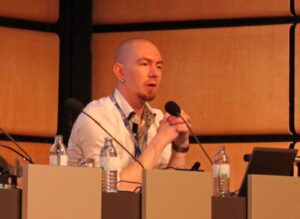
Mr. Mayhew was invited to discuss States’ experiences in amending or rescinding outdated small quantities protocols (SQPs), an option for States with little to no nuclear material to reduce the reporting and inspection requirements under their safeguards agreement.
During the session, entitled “Safeguards Implementation in States with Small Quantities Protocols – Strategies for Success”, Mr. Mayhew discussed the VCDNP’s work to support States with SQPs in implementing their safeguards obligations. He referenced the work of the Center in drawing attention to the challenges that countries face and how they mitigate them. He highlighted a brief produced by the VCDNP to help States understand the process and benefits of amending or rescinding their outdated SQPs. He also discussed the Center’s dialogue work, connecting IAEA officials, Vienna-based diplomats, and technical experts in capital for positive exchanges on peaceful uses and nuclear governance. Finally, he noted the more than 12 years the Center has spent in capacity building in nuclear non-proliferation through its short courses for diplomats and other practitioners.
Mr. Mayhew joined a panel discussion on “IAEA Partnerships in Safeguards – Working Together to Address Today’s and Anticipate Tomorrow’s Needs”. The VCDNP and the IAEA have recently concluded Practical Arrangements, an official agreement that codifies their long-standing cooperation across all substantive areas of the IAEA’s work and all three pillars of the VCDNP’s activities—impact-driven research, results-oriented dialogue, and capacity building.
Mr. Mayhew stressed the symbiotic nature of the relationship between the two organisations. On the one hand, the VCDNP supports the IAEA by conducting research on topics important to its mission, convening dialogue—including between IAEA Member States and members of the Secretariat—and by training diplomats and practitioners who work with the IAEA. On the other hand, the IAEA makes available its experts to support the VCDNP’s research, dialogue, and capacity-building activities, and facilitates VCDNP participation in important fora at the IAEA, such as conferences, symposia and workshops.
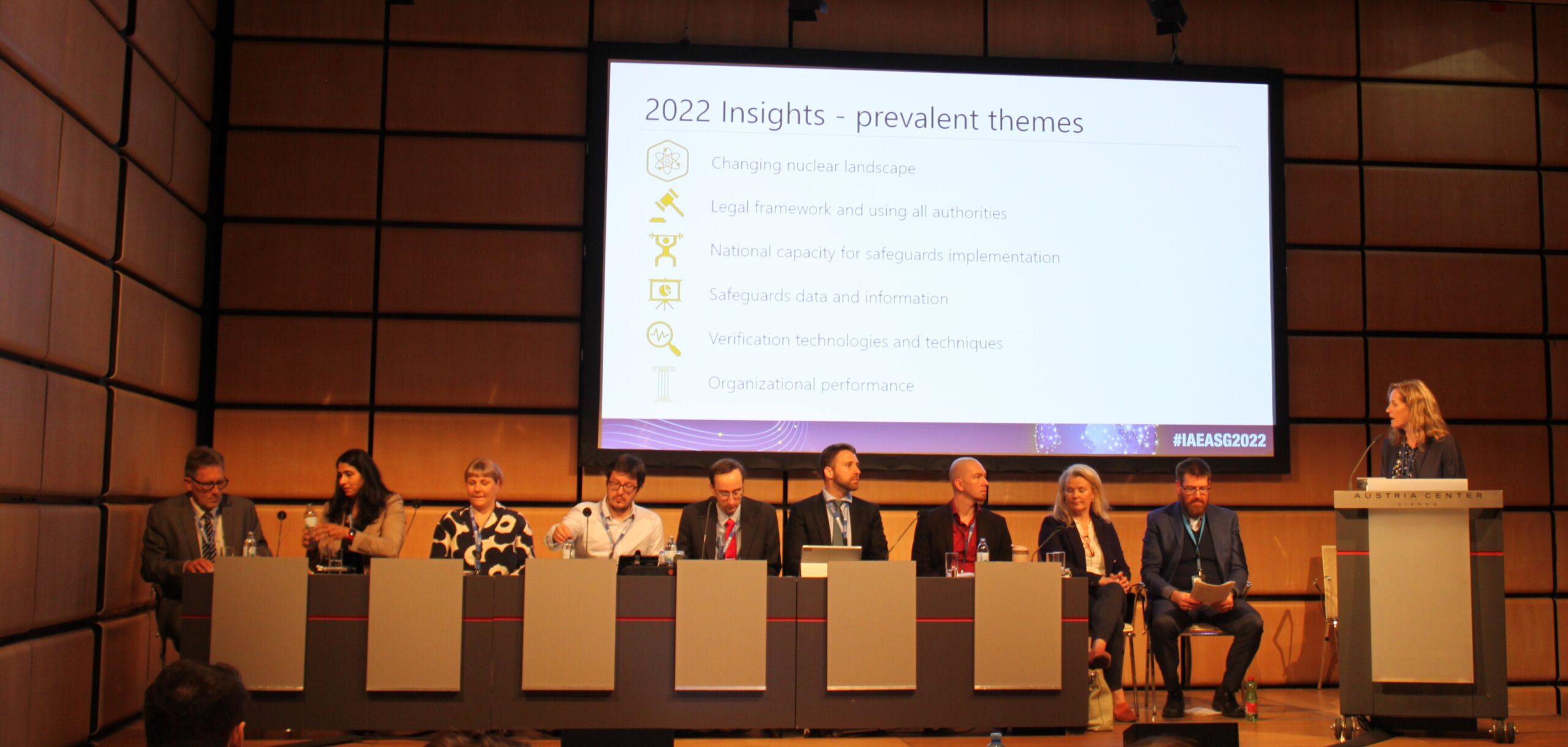


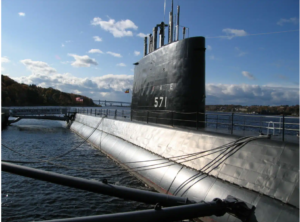

By continuing to use the site, you agree to the use of cookies. more information
The cookie settings on this website are set to "allow cookies" to give you the best browsing experience possible. If you continue to use this website without changing your cookie settings or you click "Accept" below then you are consenting to this.